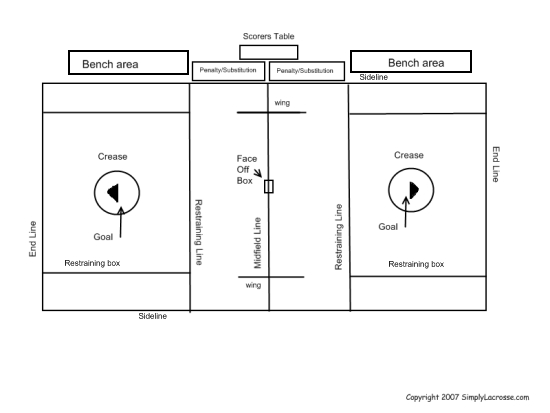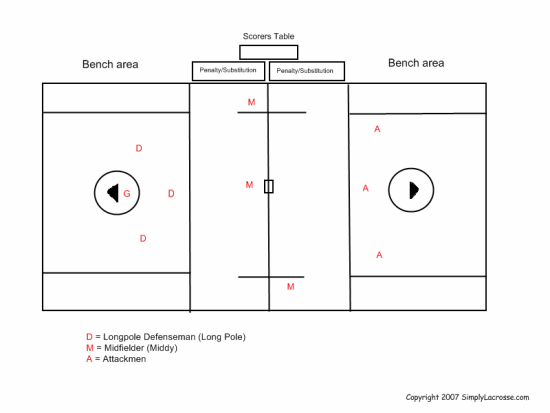Boys LAX Basics
The Object
The object of lacrosse is to score the most points. Points are scored when a player shoots ball into the opponents net. Players cannot use their hands to throw the ball into the net.
The Length of Play
Games are divided into four timed quarters. The length of the quarter depends on the age group of the game being played.
- Youth quarters are typically 8 minutes long.
- High School quarters are 12 minutes.
- College, Pro, and International games have 15 minute quarters.
At the end of each quarter teams must switch ends. When time runs out at the end of the fourth quarter the team with the most points wins. Ties are decided by sudden death playoffs.
The Field
The basic layout of a lacrosse field utilizing NCAA rules is 110 yards long by 60 yards wide. As compared to a football field which is 120 yards including the end zones by 53 1/3 yards wide. Lacrosse rules have been modified for most high school and youth organizations, so that a standard american football field can be utilized. Goal nets are 6' x 6' and reside within a 9' circle called the crease. The net is positioned 15 yards from the end line giving about 13.5 yards between the back of the crease and the end line.

Lacrosse Positions
Men's Field Lacrosse is played with 10 players.
3 Attackmen
3 Midfielders
3 Defenders
1 Goalie

Attack: The attackman's responsibility is to score goals. The attackman generally restricts his play to the offensive end of the field. A good attackman demonstrates excellent stick work with both hands and has quick feet to maneuver around the goal. Each team has three attackmen on the field during play.
Midfield: The midfielder's responsibility is to cover the entire field, playing both offense and defense. The midfielder is a key to the transition game, and is often called upon to clear the ball from defense to offense. A good midfielder demonstrates good stick work including throwing, catching and scooping. Speed and stamina are essential. Each team should have three midfielders on the field.
Defense: The defenseman's responsibility is to defend the goal. The defenseman generally restricts his play to the defensive end of the field. A good defenseman should be able to react quickly in game situations. Agility and aggressiveness are necessary, but great stick work is not essential to be effective. Each team should have three defensemen on the field.
Goal: The goalie's responsibility is to protect the goal and stop the opposing team from scoring. A good goalie also leads the defense by reading the situation and directing the defensemen to react. A good goalie should have excellent hand/eye coordination and a strong voice. Quickness, agility, confidence and the ability to concentrate are also essential. Each team has one goalie in the goal during play.
Basic Play
Play begins with a face off in the center Face-off square or circle. The lacrosse face off is similar to a hockey face off. Two opponents face each other and try to win possession of the ball. The lacrosse face off is different because the two players basically start on their hands and feet with their sticks laying along the center line, and the ball between the heads of the sticks. At the officials signal each player can employ a number of different to win possession of the ball, but there is no substitute for being quick or powerful. Most often the ball will be knocked or passed to a player other than the two fighting for the ball in the face off. Once a player is able to pick the ball up with their stick possession occurs. The object is to get close enough to the opponents net to throw the ball into the net scoring a goal. A goal counts as one point. In Major League (professional) Lacrosse there is a two point line where goals shot from behind that line score two points, but that is the only place the two point rule is in effect.
Offensive players maneuver down the field toward the goal by running with or passing the ball to a team mate. Players can run the entire length of the field as long as they are not offside's by not leaving enough players in the defensive end. Offensive players cannot enter the crease area that surrounds the goal. The crease is a circle that surrounds the goal and it is where the goalie works. Defensive players can enter the crease area. If an offensive player enters the crease, it is a crease violation and position goes to the opponent. Offensive layers cannot go into their own crease either unless they gain possession while in the crease they can take the ball out.
Transition Timing
If the goalie makes a save and gains possession of the ball he must pass or take the ball out of the crease within 4 seconds or the ball will be awarded back to the opponent.
As the ball is transitioned from the defensive end toward the offensive end the offensive team has 20 seconds to cross midfield. Once they cross midfield they have 10 seconds to move into the attack area. These time restrictions help greatly to keep teams from going into a shell. They must move the ball or possession is lost.
Unique Rules
One of the real different rules in lacrosse is that when a player takes a shot and the ball travels out of bounds the team that is closest to the line where the ball went out of bounds has possession. Often the offense will position a player behind the goal so that when a shot is made they will be closest to the spot where the ball went out of bounds when the ball goes out of bounds. You will also see the goalie sprint toward the back line when a shot is made to try to be the closest to the line so that the defensive team will gain possession. The stick is an extension of the player so they will thrust their stick toward the line to be closest.
Another fantastic rule is that after a score there is a face off. So the team who just scored could easily gain possession again by winning the face off and this leads to runs where a team may score several unanswered goals which allows a team to come back and it is one of the reasons why lacrosse is such a tremendously exciting game.
In the final two minutes of the game the team that is ahead must play with the provision that they must stay within the attack zone. Failure to stay in the attack zone constitutes offensive delay of game and possession will be transferred to the losing team. This only applies to the team that is ahead.
The Possession
During a face off teams are required to keep four players including the goalie behind their own defensive restraining line, and three attackers behind the offensive restraining line. During the face off the 3 midfielders from each side fight for possession of the ball.
Once a player picks the ball up with his stick and controls it possession occurs and the defensive players may now move forward to the midfield line if they so choose and attackers may move back to the midfield line as well if they so choose, but teams must maintain 4 defensive players in their own half of the field during play and three attackmen on the offensive half of the field. It does not matter which of the players stay on which half as long as 4 defensive players and three attack are maintained at all times. Defensive players are allowed to go on the attack including the goalie as long as a midfielder stays behind to keep the number of defenders at 4.
If a defender crosses the midfield line and the number of defenders in their own end is less than four, offside's occurs and possession is awarded to the opponent. Likewise if an offensive player leaves the offensive half of the field and a midfielder does not stay behind to keep the number of offensive players at least three. This aspect of the game allows for creative transition play. Defenders can initiate a fast break as long as a midfielder stays behind.
The Check
The game of lacrosse is very physical and contact is very much a part of the game. Being aggressive and physical is a very good quality to have. Checkingis a basic lacrosse skill. There are two different types of check that can be employed. Stick Checks and Body checks. Stick checks can be made as long as the attempt is to try to contact the opponents stick.
The goal of the game is to score the most goals, but the real challenge is in maintaining possession of the ball until a shot can be made. Once a player establishes possession keeping it is not easy. Defending players attack the stick of the player in possession and try to knock the ball loose with their own stick. This is called stick checking. They can also hit the ball carrier or anyone within 5 yards of a loose ball with their shoulder like a football block. This is called a body check and is legal as long as it not from behind, above the waist, and below the shoulder.
Lacrosse Penalties
There are two types of penalties – Technical fouls and Personal fouls.
Personal fouls - Slashing, Tripping, Illegal Cross Checking, and checking from behind a player are usually given 1 minute penalties. Penalties can be increased to 2 or 3 minutes or even ejection can be assessed for major or especially sever personal fouls.
Technical fouls such as - Offside's, Crease violations, pushing from the rear, thumbing. and Warding Off constitute a loss of possession.
Playing a Man Down
When a personal foul penalty occurs and a one minute (or longer) penalty is assessed the offending player is remove to the penalty area in front of the scorers table. The player must remain in the penalty area until the penalty has been served.
You can find an official rule book at the US lacrosse web site.
